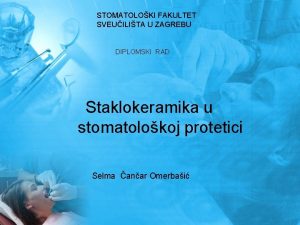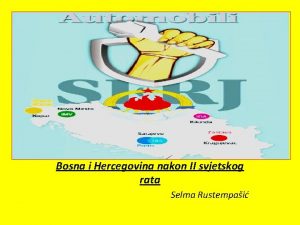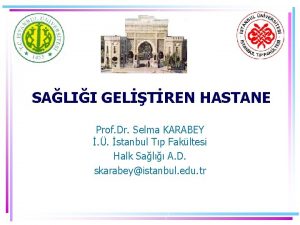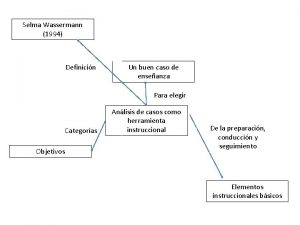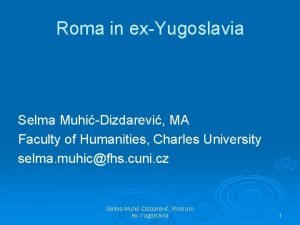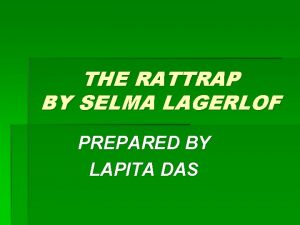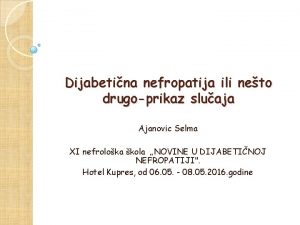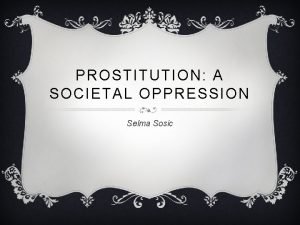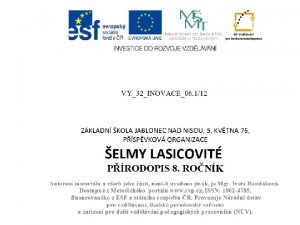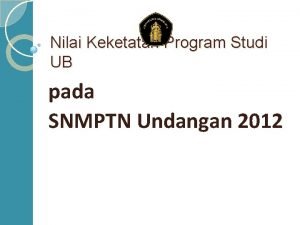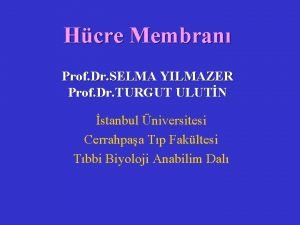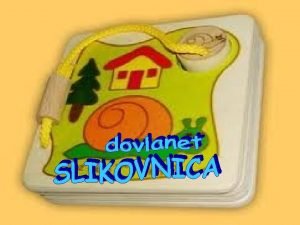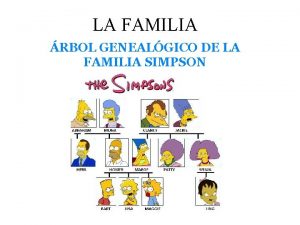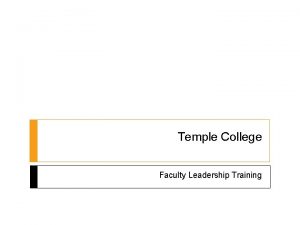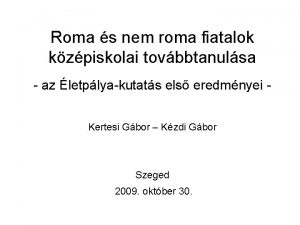Roma in exYugoslavia Selma MuhiDizdarevi MA Faculty of


















- Slides: 18

Roma in ex-Yugoslavia Selma Muhić-Dizdarević, MA Faculty of Humanities, Charles University selma. muhic@fhs. cuni. cz Selma Muhić-Dizdarević, Roma in ex-Yugoslavia 1

About ex-Yugoslavia Selma Muhić-Dizdarević, Roma in ex-Yugoslavia 2

Former Yugoslavia, 1981 census Serbs Croats Bosniaks (Muslims) Slovenians Albanians Macedonians Montenegrins 36. 3% 19. 7% 8. 9% 7. 8% 7. 7% 6. 0% 2. 6% Hungarians Yugoslavs Roma Turks Slovaks Bulgarians Romanians Italians Others Selma Muhić-Dizdarević, Roma in ex-Yugoslavia 1. 9% 5. 4% 0. 7% 0. 5% 0. 4% 0. 2% 0. 1% 1. 7% 3

Ethnic majority map in former YU Selma Muhić-Dizdarević, Roma in ex-Yugoslavia 4

Josip Broz Tito Selma Muhić-Dizdarević, Roma in ex-Yugoslavia 5

The national question Ø Ø Ø Name: Socialist Federative Republic of Yugoslavia, one party, one leader – many nations Nations and nationalities, nations – constitutive; nationalities – high standard of minority rights, provided they were able of self-organizing After the World War II, rapid development, industrial revolution, workers self-management Freedom to travel (used by many, a lot of guestworkers in Austria, Germany, etc. including Roma) Tito`s economic policy: get loans from the capitalists, keep the distance towards them, but also towards other socialist country (Tito – the bloody hound) Selma Muhić-Dizdarević, Roma in ex-Yugoslavia 6

The national question Ø Ø Ø Ø Semi-Confederative Political Structure Provisions for “Equitable Regional Representation” Complex procedures for negotiation and consensus formation Explicit recognition of all interests, including ethnicity (as long as they were not antisocialist) Death of Tito—May 4, 1980 Rising Regional Inequalities SANU Memorandum— 1986 Selma Muhić-Dizdarević, Roma in ex-Yugoslavia 7

Roma in Slovenia 6. 500 – 10. 000 of Roma in Slovenia Ø Indigenous Roma, settled, mostly on social aid Ø Roma who moved from other republics of the former SFRJ are in a legal limbo, like Slovak Roma in the CR Ø Romany children generally receive separate education Ø Indigenous Roma do have political local representatives, non-indigenous remain excluded (deficiencies in basic services, such as water supply and waste removal, are compounded by low education and high unemployment) Ø Possible lack of willingness to cooperate on Romani side, too Ø Selma Muhić-Dizdarević, Roma in ex-Yugoslavia 8

Roma in Croatia 9463 according to the 2001 census 0. 21%: problems with the name (Cigani) and lack of willingness to admit their nationality, Council of Europe estimates 30 – 40 000 Roma in Croatia. Approximately half of them in northwestern part and the capital Zagreb. Ø Ministry for Family, Defenders of the Country and Intergenerational Solidarity adopted in January 2005 an Action Plan for Roma inclusion until 2015. Ø Selma Muhić-Dizdarević, Roma in ex-Yugoslavia 9

Roma in Croatia Language was excuse not to give citizenship to Croatian Roma, therefore they cannot work legally, have health insurance or receive social benefits. Ø Political representatives in the Parliament - one, who also represents literally: Austrian, Bulgarian, German, Polish, Romanian, Russian, Turkish, Ukrainian, Jewish … national minorities. Ø Croatian Ministry of Education was taken to national court for segregating Roma children – result, court decided that quality of the education is the same, but that separation into different classes is rightful because of the language issue (children even ate separately during breaks). Ø Selma Muhić-Dizdarević, Roma in ex-Yugoslavia 10

Roma in Bosnia and Herzegovina 8864 according to 1991 census, before the war, which is 0. 2%. Ø In Bi. H there are constitutive and non-constitutive nations, the latter cannot engage in political life equally and Roma are among those. Some Rome cannot vote, because they have no documents or are stateless. Ø According to ERRC report, 30. 000 of Roma were subjects of ethnic cleansing, by all three sides, 70 of them were among 8. 000 massacred in Srebrenica. Most of them ended up in Serb-run concentration camps. Ø Selma Muhić-Dizdarević, Roma in ex-Yugoslavia 11

Roma in Bosnia and Herzegovina Ø Romani men were also forcibly conscripted and made to perform slave labour in the armies of all sides to the conflict. Many Romani women were raped and/or forced to perform sex labour. The 19921995 war saw the wholesale destruction of a number of Romani communities Ø Most of them are internally displaced persons, unable to claim their pre-war property. Ø Roma living in informal settlements or who lived in social housing before the war are frequently excluded from the benefits of new property laws and are in many cases ineligible for the aid money that has poured into the country under reconstruction schemes. Selma Muhić-Dizdarević, Roma in ex-Yugoslavia 12

Roma in Serbia and Montenegro 143. 000, 1. 44% in SCG, according to census, informally 450. 000, which makes them the biggest national minority, after NATO established protectorate in Kosovo. Dispersed all over SCG Ø Discriminated in education (again special schools), housing, employment, in access to social welfare benefits, in public spaces, by landlords, including violent attacks, mostly performed by the local bullies – insufficient or no protection by the state authorities. Ø Roma are denied access to many private night clubs, sports centres, and discotheques on the excuse that the premises are currently hired for a private party or that the Roma visitors are not properly Ø dressed. Selma Muhić-Dizdarević, Roma in ex-Yugoslavia 13

Roma in Serbia and Montenegro Residents of Roma settlements are frequently forcibly evicted and forced to live in temporary shelters. Ø In Kosovo: before NATO intervention, in a better position than Albanians, after intervention forcibly resettled and labelled collaborators (with Serbs), as refugees in Serbia, they received a very poor treatment. Ø Political presentation: none on federal or any of the republic levels, some on local level Ø Selma Muhić-Dizdarević, Roma in ex-Yugoslavia 14

Roma in Macedonia 55. 575, according to 1991 census, which 2. 73% of population, real estimates are 200. 000 Ø The majority of researchers and/or institutions focusing on the Macedonian Roma have come to the conclusion that comparatively speaking, Macedonian Roma are much better off than the Roma in any other country of the region. After 1991, President Kiro Gligorov has shown his sympathy towards the Roma on many occasions He and other leading politicians identified Roma as one of Macedonia’s major nationalities. Ø The post-1991 authorities granted the Roma with a legal status that they have never enjoyed before -- they became constitutionally equal to the Albanians and the Turks in Macedonia. Ø Selma Muhić-Dizdarević, Roma in ex-Yugoslavia 15

Roma in Macedonia There are Roma police officers and representatives from Roma parties in the parliament In the previous parliament, Roma had two deputies. Now there is only one deputy in the present parliament. Ø In the Shuto Orizari district, Roma enjoy self-government and are represented by their first Roma mayor, Nezhdet Mustafa, and there is a Town Council dominated by Roma. Ø The materials published during the 1994 census had translation in Romani, along with Macedonian and the language of the constitutionally mentioned minorities. Ø Selma Muhić-Dizdarević, Roma in ex-Yugoslavia 16

Common features in all countries Ø National or ethnic minority Ø Poverty, discrimination in legal matters, segregation in education, unemployment Ø Roma tend to accept religion of a community they happen to live in Ø Adored as gods of music, abused in folklore presentations Selma Muhić-Dizdarević, Roma in ex-Yugoslavia 17

Romani NGOs in the selected countries Ø Ø Slovenia: 8 Croatia: 25 URL www. umrh. hr Bosnia: 9 SCG: 115, www. durn. org. yu, www. rrominterpress. org. yu, www. ric. org. yu, www. lprs. org. yu, www. hur. org. yu, www. bahtalodrom. org. yu, http: //ico. yu, http: //ius. org. yu, www. medijaklub. cg. yu Ø Macedonia: 101 Selma Muhić-Dizdarević, Roma in ex-Yugoslavia 18
 Unit of bmr
Unit of bmr Selma čančar omerbašić
Selma čančar omerbašić Selma arıkan
Selma arıkan Selma rustempašić
Selma rustempašić Selma karabey
Selma karabey Selma wassermann
Selma wassermann Selma muhic
Selma muhic The rattrap by selma lagerlof
The rattrap by selma lagerlof Ehogenija
Ehogenija Oppression thesis statement
Oppression thesis statement Selma sosic
Selma sosic Selma sosic
Selma sosic Nejmenší lasicovitá šelma
Nejmenší lasicovitá šelma Keketatan ub
Keketatan ub Selma sosic
Selma sosic Selma abdul
Selma abdul Eritrosit periferal membran proteinleri
Eritrosit periferal membran proteinleri Selma kadic dekovic
Selma kadic dekovic Madre de bart lisa y maggie
Madre de bart lisa y maggie

